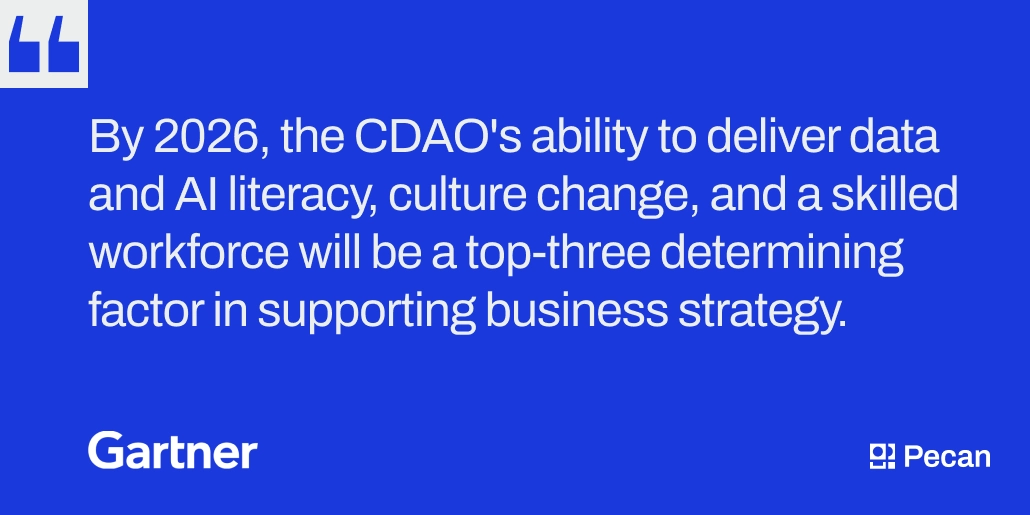In a nutshell:
- AI is becoming increasingly important in organizations, with nearly 80% considering its use.
- AI literacy is crucial for efficiency, data-driven decisions, and profitability.
- Data leaders play a key role in developing AI literacy within their organizations.
- Strategies for improving AI literacy include assessing current comfort levels, hands-on projects, and leveraging third-party resources.
- Pecan AI's Predictive GenAI capabilities can help organizations improve AI literacy with low-code analytics.
AI is likely bubbling up in discourse at your workplace, your LinkedIn feed, and even in conversations with your parents. Nearly 80% of companies are either using or considering using AI in their workflows — and for good reason. The benefits of AI are extensive. Integrating artificial intelligence can make your organization more efficient, more data-driven, and more profitable.
But you can't expect to blend AI into your company overnight. Developing your organization's comfort level (aka literacy) with AI can be tedious. As a data leader, it's your responsibility to grow your company's AI proficiency — but how?
In this article, we define AI literacy and detail your role in helping to take your organization's AI skills to the next level. We'll also cover the benefits of AI literacy for you as a data leader and for your company. Finally, we'll provide a few strategies to help you improve your organization's AI literacy.
What is AI literacy?
AI literacy is an organization's level of competency in integrating artificial intelligence into company processes. When considering AI literacy at the company-wide level, you'll need to include a variety of teams and departments — not just your data crew.
The levels of AI maturity, based on Microsoft research
One key way to assess your company's AI literacy is by determining your AI maturity. AI maturity relates to the level of an organization's usage and understanding of AI. Microsoft places AI maturity on a spectrum with four tiers, which are:
- Foundational maturity is an entry-level (or even non-existent) comfort level with AI. Organizations at this level aren't terribly familiar with AI and certainly haven't integrated it much into their work processes. The culture surrounding AI at foundational organizations is skeptical and unsure.
- Approaching maturity is the next tier, where organizations are beginning to implement AI and getting more comfortable with its use cases. At this tier, they're more positive about the technology than skeptical, and they begin investing in tools.
- Aspirational maturity organizations are comfortable with AI and are beginning to think about deeper ways to integrate it throughout the business. Companies in this tier are considering AI innovation and might begin pondering creating their own tools (such as their own LLMs). They're also getting curious about ethical implications.
- Mature organizations have a deep knowledge of AI and its use cases. They're taking full advantage of AI within their organization and are likely to be leaders within their industry regarding AI integration. They're likely using custom tools. Ethical considerations are an integral part of this level of maturity.
The data leader's role in developing literacy
AI literacy is a high priority for today's data leader
As a data leader, it's your job to lead your organization from a low level of AI literacy to a higher level of AI literacy. It's not always a clear-cut process because integrating AI into your company means looking at obstacles from a few different perspectives. These may be:
Cultural perspective
An early limitation to AI literacy development is company culture. Often, organizations with a poor understanding of AI are skeptical or critical of AI initiatives.
As a data leader, it's your job to help shift your company's perspective. If there's skepticism (or even fear of job loss), you'll need to communicate clearly to address concerns. If your company is open to integration but not prioritizing it, you'll need to make a convincing case for how AI can further your goals.
Additionally, discussions of AI can be anxiety-inducing for individuals within your organization. Prioritize developing a culture of open communication so that those individuals see AI as a powerful tool rather than a replacement.
Actionable implementation
Once you've achieved cultural buy-in, you'll need to analyze what internal processes within your company AI can improve. Because the goal is company-wide AI literacy and integration, you'll need to take time to understand each department's processes and obstacles to success and where AI's unique strengths can provide the most value, e.g., automation and analysis of large amounts of data for scalable insights.
Strategic considerations
Strategy is another important perspective to assess when determining and addressing your organization's AI literacy. While you want AI integrated into on-the-ground practices, it's also important that it's an element of your overall workforce strategy.
AI can serve marketers, salespeople, data engineers, executives, and more. Initiate conversations with each department, its leaders, and executives to understand their strategic approach and gain alignment on your AI strategy, including elements like budget and prioritization.
Educational aspects
You'll likely be responsible for initiating the educational element of bringing AI to your organization. Orchestrating AI integration can't happen without education, and as the AI initiative's leader, you'll need to organize training regarding specific AI tools, especially for your data analytics team.
Ethical issues
A final perspective you'll need to address when you begin integrating AI into your organization is the ethics of the tool in question. What kind of data is it built on? How will your data be used? Is it committed to ethical and responsible usage of AI? Employees may also be coming to the table with privacy, bias, and accountability concerns, so be sure to consider ethics as you develop your AI program.
Additionally, you'll need to ensure that whatever program you're using is compliant with regulations and governance needs for your organization. Speak with your data security team to ensure that any data that AI uses is mapped and used appropriately.
The benefits of increasing AI literacy within your organization
There are seemingly endless benefits for improving AI literacy in your company for both you and your organization. As a data leader, increasing AI literacy means:
- Skill enhancement relating to data science, AI, and project management
- Increased visibility into data across your company
- Strategic influence within your department and cross-functionally
- Enhanced decision-making capabilities within your organization
Within your organization, improving AI literacy has a long list of positive outcomes, including:
- A 6% to 10% increase in revenue after the integration of AI
- An increase in productivity (potentially by 40%)
- An improved culture of innovation and creativity
- A 15% to 20% increase in sales productivity
- A 20% increase in order management throughput
As more organizations integrate artificial intelligence into their processes, the technology's impacts will only become more pronounced. In addition, driving change is part of the criteria for success for data leaders. Gartner predicts that "in 2026, 75% of CDAOs that have failed to make organization-wide influence their top priority will have been assimilated back into technology functions."
Data leaders must drive meaningful cultural change and data/AI literacy initiatives
Strategies for increasing AI literacy
Now that we've defined AI literacy and your role in making it happen, as well as the benefits to both you and your organization, let's take a look at how you can improve AI literacy at your company.
Gauge present comfort level with AI
Before you tackle improving AI literacy, we recommend assessing your company's present comfort level with the technology. As discussed above, look at your organization's culture, processes, strategies, and education level as they relate to AI.
You will also want to take your organization's AI maturity into account. Rather than attempting to bring your organization from a foundational level of maturity to a fully mature level overnight, we suggest taking a slow and intentional approach to AI improvement. Start with an assessment and develop your strategy from there.
Hands-on projects
While courses and guidebooks can help some learners understand how to use AI in their roles, hands-on projects are a great way to create a culture of AI while teaching how to use the technology.
Assign projects to departments or work cross-functionally on hands-on projects that teach both AI tools and AI fundamentals. These projects could be anything from using a solution's free trial to gaining a new certification to using GenAI to write code. These projects don't necessarily need to be tied to business outcomes — as long as they help build familiarity with AI and instill confidence. Once you've assessed your organization's current comfort level with AI, you can design more tailored hands-on projects that help address any weaknesses.
Differentiate programs across roles and departments
While the goal may ultimately be to increase AI literacy across the board so all departments are equally competent in AI usage, you may want to differentiate programs between departments based on use cases.
For example, your organization's sales team may use AI in a more limited capacity (e.g., sales lead scoring and email generation) than your data analytics team (e.g., feature engineering, model building, and writing code). Thus, an in-depth AI program may be less necessary for departments that use AI less and create a culture of resistance. Take a differentiated approach so each department feels like their AI education and tools are directly related to their goals and processes.
Leverage third-party resources
You're not alone in your pursuit of increasing AI literacy; in fact, lots of third-party resources have been created to help reach this goal. While the specific tools you're using for your organization likely have tutorials and instructional guides, more general AI educational platforms are available, such as edX and Humans for AI.
Consider bringing in subject matter experts to talk to your company or executives about implementing AI. The more leaders within your organization understand the value and use cases of AI, the higher your AI literacy is, and the better you'll be able to use AI tools.
Establish an AI mentorship team
To help infuse AI education into your organization's culture, consider creating an AI mentorship team with members from multiple departments. Employees may feel most comfortable asking questions to colleagues they work with daily, so creating a mentorship team with departmental AI leaders could be a great way to help them feel like help is accessible.
An interdepartmental AI mentorship team also creates a cross-functional culture where your AI leaders are in close conversation with one another. As problems or opportunities for learning arise, your mentorship team can quickly communicate with one another to find a solution or approach.
Measure AI integration
Once your AI initiative is off the ground, you'll want to measure its impact using several metrics. On the one hand, you'll want to measure AI's results as they relate to business outcomes such as growth and profit. On the other hand, you'll want to measure the comfort level of your employees and team members to see if internal literacy is improving. You'll get the most from your AI investment if your employees enjoy using the technology and see the value.
Implement accessible AI tools
You've undoubtedly discovered a wide range of complexity in your research for AI tools to bring to your organization. One key way to elevate AI literacy quickly is by using accessible, intuitive AI tools that don't require a coding background.
Low-code tools — like Pecan's predictive analytics platform — still create impactful output without requiring deep technical knowledge. Many generative AI tools, for example, are accessible via a simple chat interface. Easy-to-use tools build confidence in users and set a great foundation for more intricate use cases.
Overall, be careful not to jump into the deep end when first developing your organization's AI literacy. Provide educational opportunities and spaces to ask questions, begin integration slowly and intentionally, and incorporate intuitive tools into your tech stack.
How Pecan AI can improve your organization's AI literacy
Rolling out AI within an organization can feel like an uphill battle. From navigating culture clashes to providing tooling instruction, it's not always easy to get an entire organization on the same page regarding artificial intelligence.
Pecan's Predictive GenAI capabilities make it easy to get started with AI. Pecan is a low-code analytics platform that combines high-impact AI with low technical knowledge.
When a user decides to develop a model within Pecan, it starts with a generative AI conversation — the Predictive Chat. Rather than inputting complicated code or having to be an expert on framing AI queries, the bot guides the user through a conversation to gather the information necessary to construct a model — what do you want to solve for, which variables are most important, and so on.
Once the chat has the info it needs, the modeling process is fully automated within Pecan. SQL for your model is instantly generated, and users can adjust the model from there either manually or with the help of an AI assistant.
Pecan's low-code platform means your AI growth is only as limited as your imagination. With nearly endless use cases, you and your organization can quickly reap the benefits of improved AI literacy.
To learn more about Pecan's predictive modeling platform, schedule a demo with our team. We'll show you around the platform and demonstrate the incredible value predictive AI can bring to your organization.






